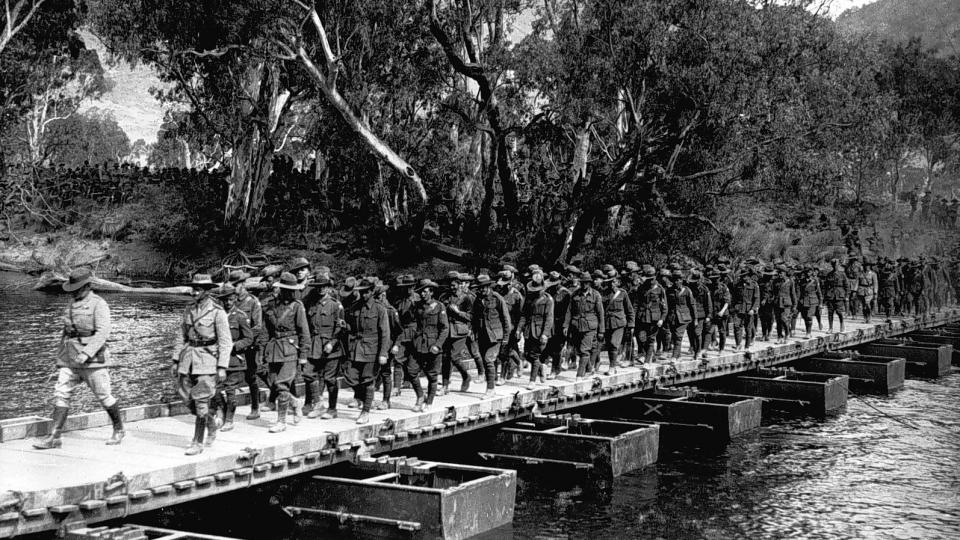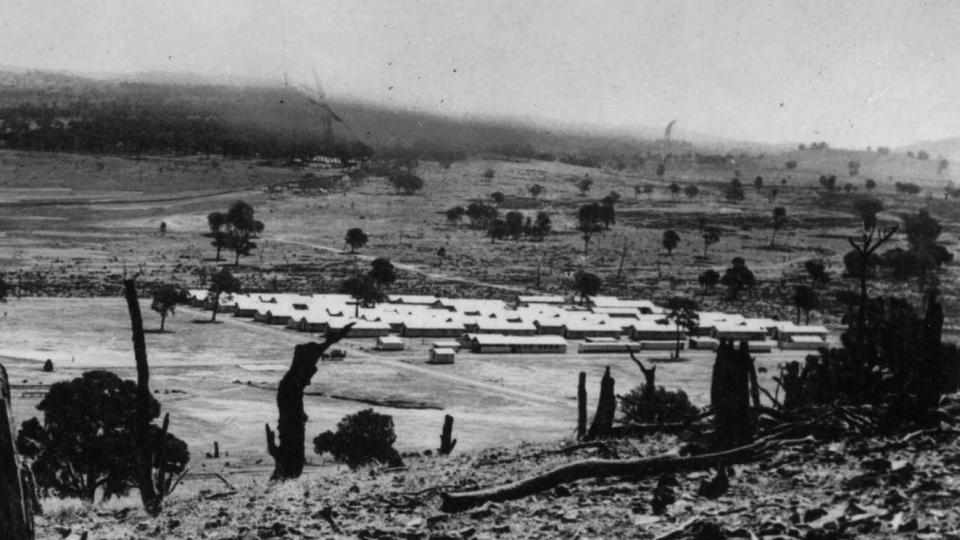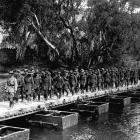The relationship between war, militarization, and landscapes is far more complex and nuanced than one characterized by domination and destruction. While the preparation, waging, and aftermath of war clearly have a range of negative landscape impacts, military forces are holding increasingly important, complementary roles in the defense of high-conservation value sites.
Scientists have observed that training areas used by defense forces, to the exclusion of all others, have provided sanctuary for numerous species of flora and fauna. Environmental historians, too, have begun to focus on the histories of militarized landscapes.
Australia, where the Department of Defence holds three million hectares of land, has not been given much attention so far. An exemplary case, however, is found at Puckapunyal. Its restoration in the 1970s and 1980s is an early example of military environmentalism in Australia.
Puckapunyal Military Training Area in central Victoria is home to 44,000 hectares of box-ironbark ecosystem, of which over three-quarters has been cleared elsewhere in Victoria. There are 12 endangered or vulnerable vegetation communities, 481 indigenous and 225 introduced plant species, and 170 species of lichens, mosses, and fungi. Puckapunyal supports 185 native bird species, 17 indigenous and 15 introduced mammals, 12 kinds of bat, 18 species of reptile, and 12 species of amphibian, 7 native and 4 introduced kinds of fish, and over 140 species of invertebrates.
It is a rich site of biodiversity and holds high conservation value, now forming an extensive wildlife corridor with neighboring state parks. But this was not always so.

Australian defense forces began training at Puckapunyal during the First World War, and continued into the interwar period. This photo, taken in 1925, shows that areas of the site were still heavily forested at this time
Australian defense forces began training at Puckapunyal during the First World War, and continued into the interwar period. This photo, taken in 1925, shows that areas of the site were still heavily forested at this time
Photo courtesy of Museum Victoria.
Publisher and publication date: Donated from private collection, circa 1925.
Object name: “Negative - Puckapunyal, Victoria, circa 1925”
 This work is licensed under a Creative Commons Public Domain Mark 1.0 License.
This work is licensed under a Creative Commons Public Domain Mark 1.0 License.
In the aftermath of European colonization in the mid-nineteenth century, the land around Puckapunyal—belonging to the Taungurung people—was utilized for intensive sheep and cattle grazing, later followed by gold mining and logging for timber and firewood in the area’s box and ironbark forests. Land degradation and accelerated soil erosion was severe in most of the area by the early twentieth century—the soils at Puckapunyal were and are particularly susceptible to erosion after disturbance.

After intensive use as one of Australia’s largest infantry training grounds during the Second World War, large swathes of the Puckapunyal site were left barren and denuded
After intensive use as one of Australia’s largest infantry training grounds during the Second World War, large swathes of the Puckapunyal site were left barren and denuded
Photo courtesy of The Argus Newspaper Collection of Photographs, State Library of Victoria.
Object name: “Puckapunyal camp site in central Victoria”
Publisher and publication date: The Argus newspaper, circa 1940.
 This work is licensed under a Creative Commons Public Domain Mark 1.0 License.
This work is licensed under a Creative Commons Public Domain Mark 1.0 License.
Military training commenced at Puckapunyal during the First World War, and the Department of Defence formally purchased the site from pastoral landowners during 1939. It became one of the largest infantry training sites in Australia, and from 1949 was home to the 1st Armoured Regiment. Historical land use impacts and heavy military usage, with little attention paid to land management or maintenance, eventually left the area barren and denuded. Although attempts at revegetation occurred in the 1950s, by the 1960s parts of the site were impassable because of waterlogging and severe erosion. For the tanks of the armored division, these areas were unsafe and unusable. One newspaper described it as the “most desolate and barren military camp in Victoria.”
By 1969, the Army was faced with two alternatives: “(1) to rehabilitate the area, or (2) to abandon it with consequent loss of facilities and the certainty of having to face similar problems elsewhere in the future.” The former option was taken. The Puckapunyal Restoration and Conservation Project began work in 1971. Officially operating under the auspices of Defence, the research and scientific support for the project was provided by the Commonwealth Scientific and Industrial Research Organisation (CSIRO), while the Victorian Soil Conservation Authority managed operations and provided its expertise in soil erosion and land restoration.
By 1985, the extensive program of earthworks, soil and water erosion control, and revegetation had been completed on 20,000 hectares of land. Some 5,000 hectares of barren and denuded landscape was repaired, and 16,000 hectares of improved pasture had been established. At the completion of the project, land management and scientific officers were appointed to continually monitor and research the Puckapunyal site. A rest and restore program was implemented, creating “no go” areas where the land was overused, where new vegetation was establishing itself or was otherwise sensitive to environmental changes, or where research was being conducted.
The evolution of land management at Puckapunyal (and broader Defence environmental initiatives that came after the project) from the 1970s until the present is an obvious example of military environmentalism in an Australian context. The incorporation into defense policy of the notion of military training areas as de facto wildlife reserves is a key feature of so-called “khaki conservation,” along with stringent environmental processes and controls, and greater focus on transparency and accountability in matters relating to the environmental impact of defense activity. “Swords to ploughshares” programs, in which disused military sites are turned over to conservation or agriculture, are also becoming more commonplace.

These two images show: After an extensive restoration program in the 1970s and 1980s, and continued environmental monitoring, the Puckapunyal site was entered into the Australian Commonwealth Heritage List in 2004
These two images show: After an extensive restoration program in the 1970s and 1980s, and continued environmental monitoring, the Puckapunyal site was entered into the Australian Commonwealth Heritage List in 2004
Photo courtesy of the Department of the Environment and Energy.
Creator: Mark Mohell
Publisher and publication date: Department of the Environment and Energy, 2002.
 This work is licensed under a Creative Commons Public Domain Mark 1.0 License.
This work is licensed under a Creative Commons Public Domain Mark 1.0 License.
Some have argued that increasing emphasis on conservation in the past few decades is merely rhetoric to justify and “greenwash” environmental damage and military occupation of land. Indeed, the response of Defence to an ongoing—and likely successful—Taungurung traditional land ownership and recognition claim remains to be seen.
At the same time, however, conservationists note the unexpected environmental benefits of military sites from which most human activity is excluded. In either case, Puckpunyal highlights the ways in which environmental concerns have entered into Defence policy and suggests that, far from being a simple relationship of domination and destruction, the environment and the military can relate in complex, contradictory, and unexpected ways.
How to cite
Wilkie, Benjamin. “Bombs and Biodiversity: A Case Study of Military Environmentalism in Australia.” Environment & Society Portal, Arcadia (Autumn 2016), no. 15. Rachel Carson Center for Environment and Society. https://doi.org/10.5282/rcc/7678.
ISSN 2199-3408
Environment & Society Portal, Arcadia
 This work is licensed under a Creative Commons Attribution 4.0 International License.
This work is licensed under a Creative Commons Attribution 4.0 International License.
2016 Benjamin Wilkie
This refers only to the text and does not include any image rights.
Please click on an image to view its individual rights status.
- Coates, Peter, Tim Cole, Marianna Dudley, and Chris Pearson. "Defending Nation, Defending Nature? Militarized Landscapes and Military Environmentalism in Britain, France, and the United States." Environmental History 16, no. 3 (2011): 456–91.
- Machlis, Gary E., and Thor Hanson. “Warfare Ecology.” BioScience 58, no. 8 (2008): 729–36.
- Pearson, Christopher J., Peter Coates, and Tim Cole. Militarized Landscapes: From Gettysburg to Salisbury Plain. London: Continuum, 2010.
- Russell, Edmund. War and Nature: Fighting Humans and Insects with Chemicals from World War I to Silent Spring. New York: Cambridge University Press, 2001.
- Tucker, Richard P. Natural Enemy, Natural Ally: Toward An Environmental History of War. Corvallis: Oregon State University Press, 2004.
- Woodward, Rachel. Military Geographies. Oxford: Blackwell Publishing, 2004.
- Log in to post comments
- Print page to PDF








